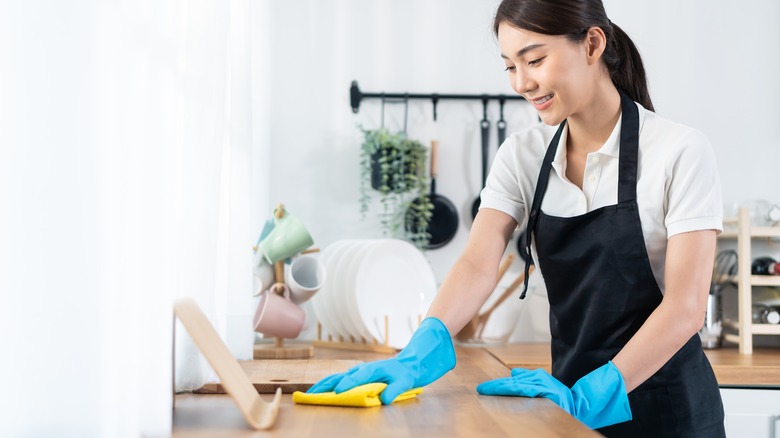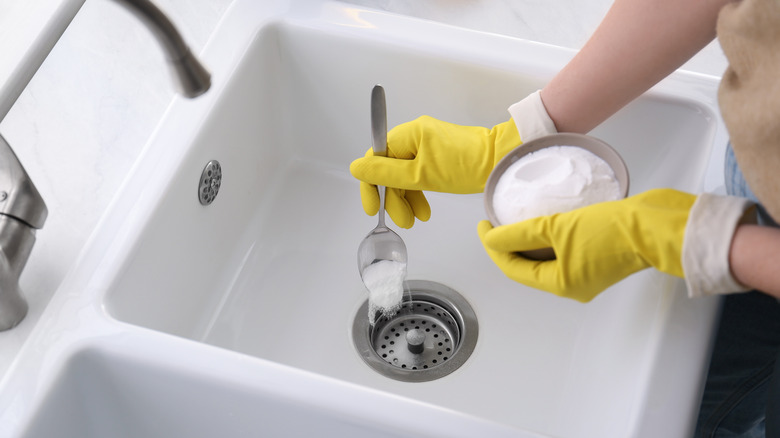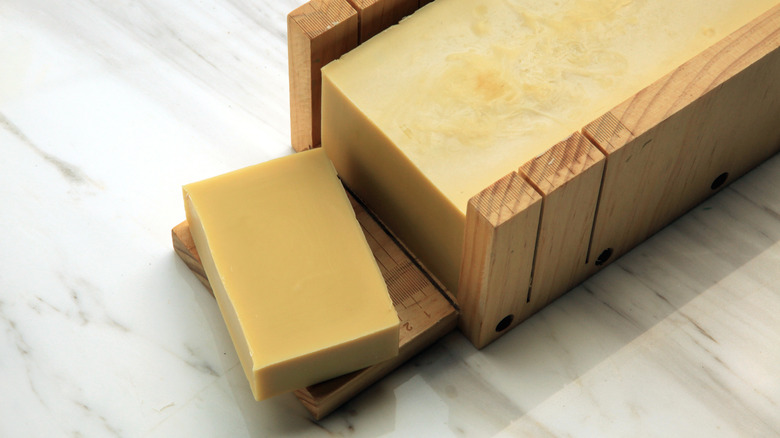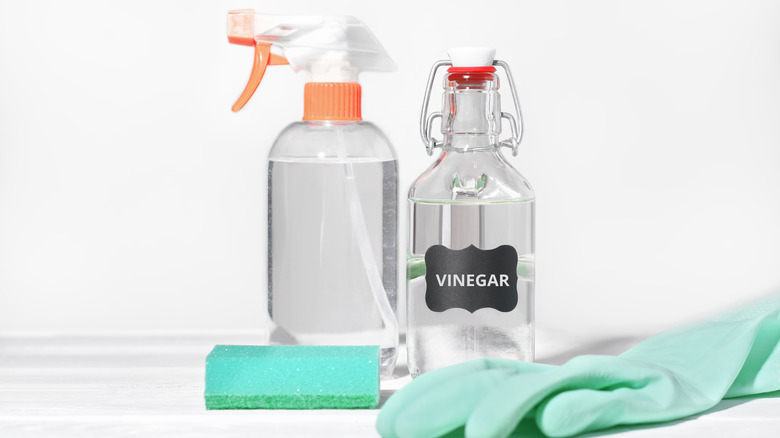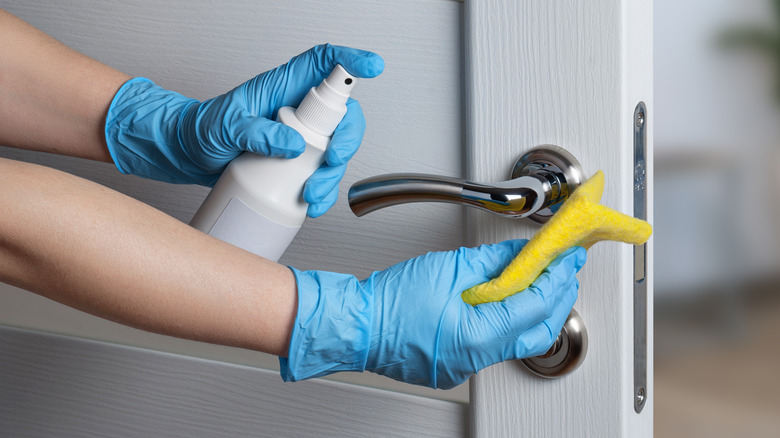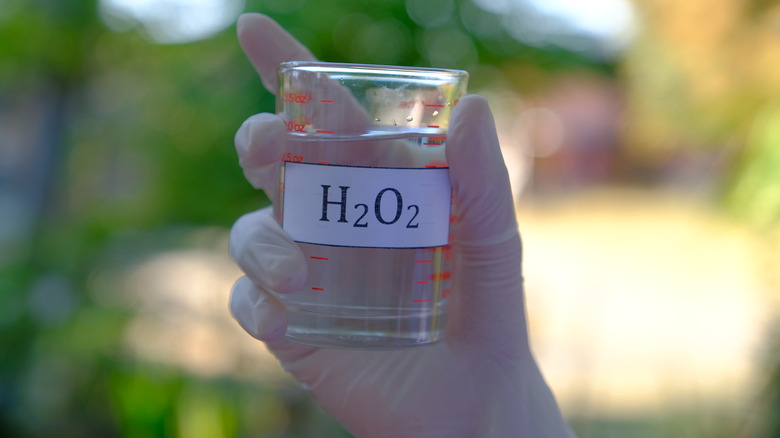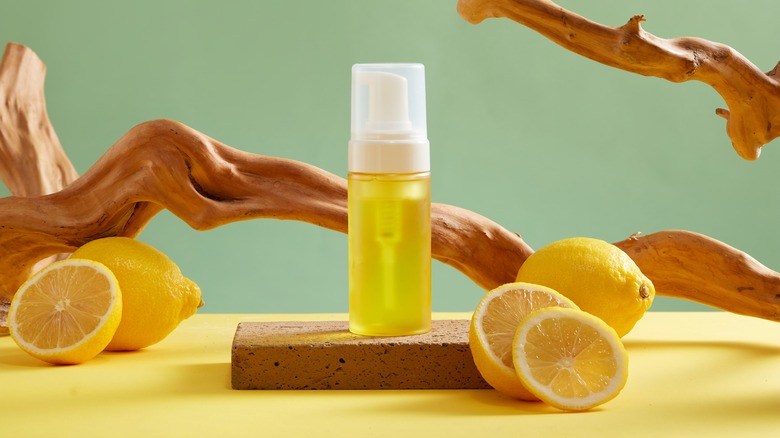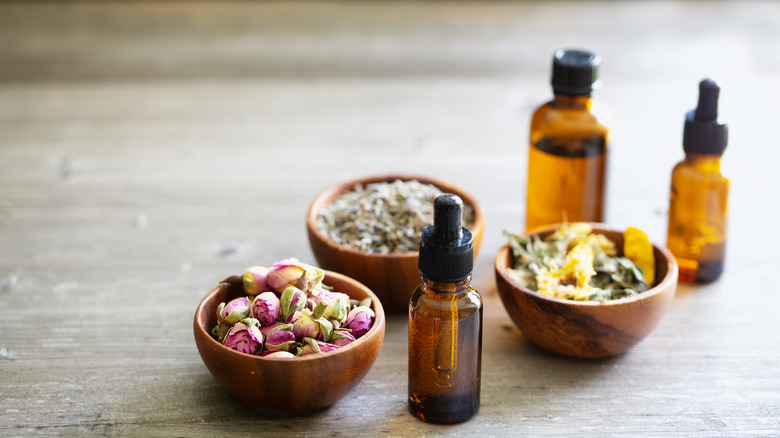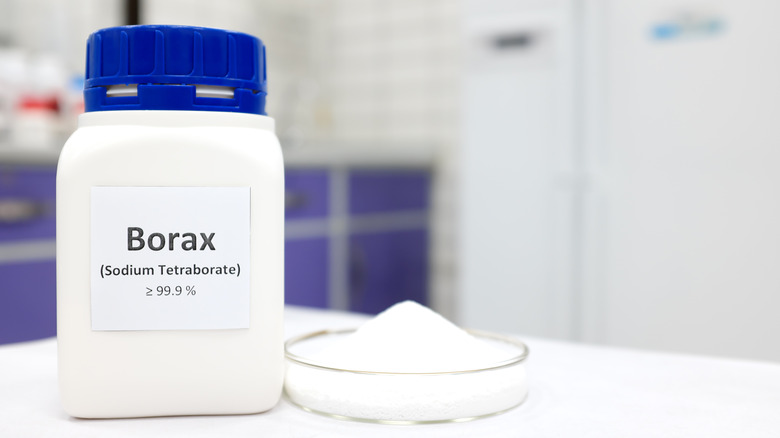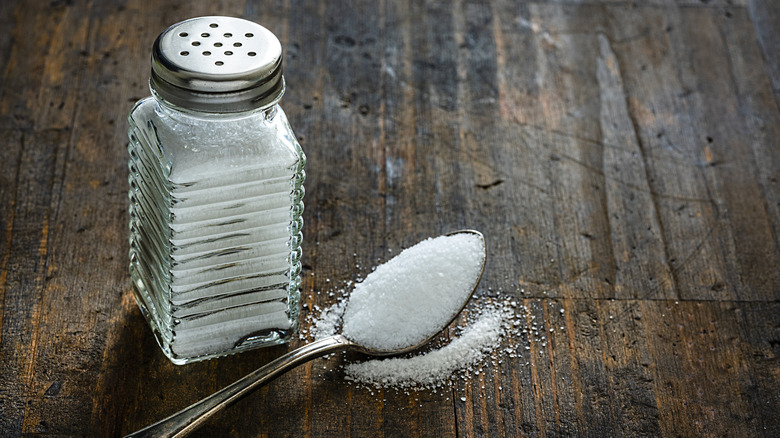Natural Cleaning Ingredients That You'll Want A Healthy Stock Of In Your Home
You might think that a clean home requires an arsenal of chemical products, but that's far from the truth. Often, those chemical cleaners contain natural ingredients in their formulas. This overlap begs the question: why not go straight to the source and use natural ingredients instead? From basic kitchen staples like baking soda and white vinegar to versatile essential oils, you'll want to keep these cleaner and bleach alternatives on hand for various tidying tasks around your home. In addition to being eco-friendly, many natural cleaning agents often come at a fraction of the cost and are less likely to trigger allergies or irritate your skin. But the real clincher? Science backs them up. These natural options often contain compounds as effective as synthetic chemicals in breaking down grime, killing germs, and removing stains.
That being said, don't be lulled into a false sense of security just because these ingredients are natural. Their chemical compositions may be naturally derived, but that doesn't make them universally safe for all cleaning applications. It helps to be vigilant when using such ingredients. Just like their chemical counterparts, natural cleaners have their own sets of dos and don'ts. Believe it or not, you can still end up with stains or surface damage if you're not careful. So, while natural cleaners offer a lot of pros, you'll still need to understand their best uses, limitations, and potential for surface compatibility.
Baking soda
You might have already come across the many baking soda cleaning hacks online. Also known by its scientific name, sodium bicarbonate, the science behind its cleaning prowess lies in its pH level, which stands at 9. That mild alkalinity gives it the power to break down proteins and fatty acids, which are often the culprits behind stubborn stains and odors. And here's something else—baking soda also possesses mild antibacterial properties. Its ability to alter the pH levels on a surface can actually make environments less hospitable for bacteria, thus playing a role in disinfection.
When using baking soda for cleaning, a little preparation goes a long way. For scrubbing action, create a paste by mixing baking soda with a small amount of water. This mixture is great for tackling stovetops, sinks, and oven interiors. You can also add baking soda directly to a damp sponge for lighter cleaning tasks, like wiping down countertops. Not only does baking soda cut through grime, but it also deodorizes. For instance, a sprinkle of baking soda can freshen up your carpets. Just apply, let it sit, and then vacuum it up. It works wonders in deodorizing chopping boards and can be run through dishwashers and drains to eliminate lingering smells. Remember to exercise caution when using baking soda. Its abrasive nature can scratch certain surfaces. Marble countertops, hardwood floors, aluminum cookware, and gold-plated dinnerware are a no-go. On these surfaces, baking soda can do more harm than good.
Castile soap
Originating from the Castile region of Spain, this soap is primarily made of vegetable oils, typically olive oil. Unlike traditional soaps that often contain animal fats or synthetic detergents, Castile soap is plant-based, making it eco-friendly and biodegradable. So,what's the science that makes Castile soap effective? Like any soap, Castile soap has molecules with a "head" that loves water and a "tail" that loves oil. When you apply it to a dirty surface, the tails stick to oils and grime while the heads stay in the water. Agitate it a bit, and voilà! The grime is lifted and encapsulated in water, making it easy to rinse away.
Castile soap is a great household cleaner and is remarkably versatile. To make an all-purpose cleaning solution, you can dilute it with water or add a few drops to a bucket of water for mopping floors. Some even mix it with baking soda for a powerful scouring agent. And let's not overlook its prowess in personal care; it's a gentle yet effective face and body wash. However, be careful when mixing with lemon or vinegar since it can result in a white residue. Also, not every surface welcomes Castile soap with open arms. Exercise caution when using it on surfaces that react poorly to pH imbalances, like natural stone countertops or certain types of wood. The alkaline nature of the soap could cause damage, so it's advisable to do a patch test first.
White vinegar
White vinegar is made from fermenting distilled ethanol. It boasts acetic acid as its active component. And it's this acetic acid that's the key player in white vinegar's cleaning abilities. So, how does the science work? The acidic nature of white vinegar, typically around a pH of 2.5, makes it effective against alkaline grime and mineral deposits. Acetic acid dissolves these substances, making it easier to wipe them away. The acid also breaks down the cell walls of various microorganisms, including bacteria, providing you with a natural disinfectant. But how should you prepare white vinegar for cleaning tasks? Typically, a one-to-one ratio of vinegar to water works well for most cleaning jobs. If you're tackling something more stubborn, feel free to use it undiluted, but do a spot test first to ensure it won't cause damage.
Diluted white vinegar is also a fantastic window shiner, leaving your glass streak-free. Combine it with a little water and dish soap, and you've got yourself an all-purpose cleaner for wiping down surfaces. It's especially effective for removing soap scum in bathrooms and tackling hard water stains. If you're dealing with persistent odors, placing a bowl of white vinegar in the affected area can help neutralize the smell. However, as with many other natural ingredients, it's not suitable for all surfaces. Avoid using it on marble or other natural stone surfaces, as the acid can etch and damage them. Also, keep it away from hardwood floors, which can be sensitive to its acidic nature.
Rubbing alcohol
Here's another cleaning agent that often sits quietly in your medicine cabinet: rubbing alcohol, also known as isopropyl alcohol. This liquid is more than just a first-aid staple, but what's the science behind its cleaning abilities? It contains a high concentration of isopropyl alcohol, usually around 70% or more, dissolved in water. This alcohol is a solvent, meaning it dissolves various substances, including oils and other types of grime. But it doesn't stop there. Rubbing alcohol also disrupts the cell walls of bacteria, viruses, and fungi, making it an excellent disinfectant.
When preparing rubbing alcohol for cleaning, it's pretty straightforward. For general cleaning, you can dilute it with a bit of water, but for disinfecting purposes, it's often best to use it at full strength. Simply put some on a clean cloth or in a spray bottle and apply it to the surface you want to clean. So, how can you incorporate rubbing alcohol into your cleaning regimen? Well, it can work well on car windows and hard surfaces where streaks are a concern. It evaporates quickly, leaving surfaces spot-free. It also works wonders on stainless steel appliances, giving them a shiny new appearance. Now, a word of caution: We earlier mentioned avoiding white vinegar on certain surfaces, and the same goes for rubbing alcohol. There are various things you should never clean with rubbing alcohol. Its solvent properties can damage some plastics, leather, and finished wood surfaces. Always do a patch test on an inconspicuous area before going all out.
Hydrogen peroxide
Let's shift gears and focus on a product you often see in brown bottles at the pharmacy: hydrogen peroxide (H2O2). While you may associate it primarily with treating cuts and scrapes, it's a highly effective cleaner and disinfectant. It is essentially water with an extra oxygen atom. That extra oxygen makes all the difference. When it breaks down, it separates into oxygen and water. This separation produces a kind of oxidation, a process that kills microorganisms and breaks down certain types of grime. The extra oxygen atom acts as a potent oxidizer, disrupting the cell walls of bacteria and other pathogens, thereby neutralizing them. This makes hydrogen peroxide a reliable, natural disinfectant.
You can use hydrogen peroxide in various ways around the home. A spray of hydrogen peroxide can freshen up and disinfect bathroom fixtures. And don't forget about its potential in the kitchen: it's useful for sanitizing cutting boards and countertops. With hydrogen peroxide, caution is advised on fabrics and carpets, as it can bleach them. Also, while it's safe on most hard surfaces, always do a patch test first, particularly on wood and antique items, to make sure it doesn't discolor or damage the material.
As for preparation, hydrogen peroxide often comes in a concentration of 3% for household use, which is generally safe and effective for cleaning and disinfecting. You can use it straight from the bottle or dilute it with water for less intense cleaning tasks. Just remember, keep it in its original brown bottle to protect it from light, which can break it down.
Lemons
Now, let's delve into a cleaning agent that adds a fresh twist to your household chores: lemons. This citrus fruit serves as a powerhouse cleaner, thanks to its natural acidity and essential oils. It is remarkably versatile for cleaning tasks. So, what's the scientific breakdown? Similar to white vinegar, lemons contain citric acid, which is effective at breaking down mineral deposits. The acid works by loosening these substances, making them easy to wipe away.
To prepare a lemon-based cleaner, it's quite simple. You can use the juice, the peel, or both, depending on the cleaning task. For an all-purpose cleaner, mix lemon juice with water and a bit of vinegar. As for the peels, they're great for deodorizing your garbage disposal. You can also soak them in vinegar for a few weeks to make a powerful, natural cleaner. To remove hardened water from your kettle using lemons, simply add a tablespoon of lemon juice and a liter of water to your kettle. Boil and leave for 15 minutes until the hardened water dissolves. To use lemons as a natural scrub for hard-to-clean items like grout and copper pots, use a halved lemon dipped in salt. That said, you might wonder where lemons shouldn't be used. Although they are generally gentle, similar to what applies to white vinegar, avoid using them on natural stone surfaces like marble and granite, as the citric acid can etch them and cause white spots.
Essential oils
Essential oils like lemon, tea tree, lavender, and eucalyptus are the aromatic heavy-hitters in the natural cleaning world. Generally speaking, they consist of a diverse blend of volatile compounds extracted from plants. They mostly contain compounds like phenols, aldehydes, and terpenes, which contribute to their antimicrobial properties. For example, tea tree oil contains terpinen-4-ol, which is effective in killing or suppressing the growth of bacteria and fungi. Similarly, lavender contains linalool and linalyl acetate, both known for their antimicrobial capabilities. These components work by disrupting the cell membranes of various pathogens, rendering them inactive and easy to wipe away.
Incorporating essential oils into your cleaning regimen is surprisingly simple, and you can prepare your own all-purpose cleaner in just a few steps. Select the oils you want to use, and mix about 30 drops with a cup of water. Shake well before each use, as the oil and water will naturally separate over time. A few drops in your laundry detergent can also add a fragrant boost while disinfecting your clothes. Lastly, they're excellent additions to homemade cleaners, where they can be mixed with water or vinegar to make sprays for hard surfaces. Now, onto the cautionary part: what to avoid. Be cautious when using essential oils on colored or delicate fabrics, as essential oils can stain them. And like with the previously mentioned natural cleaners, a spot test on porous surfaces like natural stone is always a good idea to ensure no damage occurs.
Borax
Borax is a less obvious but equally effective player in the natural cleaning game. Often overlooked, this naturally occurring mineral compound also has disinfecting properties that make it a multitasking powerhouse in your home. Here's the science: Borax is a salt of boric acid and is also known as sodium borate. It's alkaline with a pH level of around 9.3, which gives it great grease-cutting and stain-removing abilities, allowing it to break down acidic grime and dirt effectively. Additionally, borax has mild antibacterial and antifungal properties. It effectively kills these microorganisms, much like other natural cleaners we've discussed.
To prepare a borax-based cleaner, simply add a cup of borax to a gallon of warm water. In terms of applications, you can use this salt to clean toilets, scrub sinks, and even use it as a laundry booster. That being said, it's important to take care and wear protective gear since it's known to cause various health issues if ingested. This solution can serve as a multi-surface cleaner that you can put into a spray bottle for easy use. Remember to shake the mixture well before spraying, as borax tends to settle at the bottom.
Table salt
Last but not least, let's delve into something you almost certainly have in your kitchen: table salt. Far from just a seasoning, salt can be an effective cleaner for a broad range of tasks — from brightening stained linens to scouring greasy pans, salt has you covered. This is thanks to its granular structure and chemical properties. It's primarily composed of sodium chloride, a simple ionic compound that is surprisingly versatile when it comes to cleaning. Here's how it works: The small, abrasive grains of salt make it excellent for scouring and scrubbing tasks. These granules provide just enough grit to dislodge dirt and stuck-on particles from surfaces. Some salts are also hygroscopic, meaning they absorb moisture. This is particularly useful when you're dealing with mold or mildew, as it can help draw out the moisture that these organisms need to grow. While salt itself doesn't kill bacteria, when combined with vinegar or lemon, it enhances their disinfecting properties by increasing acidity.
To prepare a salt cleaner, you can create a paste with equal parts salt and water, or add lemon juice or vinegar for increased efficacy. Keep in mind that not all surfaces take kindly to salt. You should avoid using it on sensitive materials, as its abrasive nature can scratch or even remove the finish. Also, be cautious when using salt on metal surfaces; it can accelerate corrosion if not rinsed off properly.
